Elena Crippa
Michael Blum, A tribute to Safiye Behar, 2005, 9th Istanbul Biennial
One of the most successful aspects of the 9th Istanbul Biennial was
that many of the artists invited had the opportunity to stay in the
city for extended residencies that ranged from three weeks to three
months in 2005. One of those artists is Michael Blum, who realised his
work for the context of the Deniz Palace Apartments, certainly the most
interesting venue of this year biennial.
Michael Blum's project, A tribute to Safiye Behar, 2005, takes over one of the apartments of the building, transforming it into a museum to the memory of one of the most extraordinary and unknown figures of Turkish history, an incredible woman whose past is rich in intellectual, political and social engagement as much as in intriguing love affairs. Marxist, feminist, wife and mother, she also managed to find the time to engage in a long lasting relationship with Mustapha Kemal, and influence his political views and actions. Born in 1890 in Istanbul, she only permanently left her native city after Kemal's death, and rejoined her family in Chicago, where she died aged 75.
The living room, bedroom and studio of her old home in Istanbul are carefully reconstructed, while visitors can also re-draw the history of Safiye's life through the family photographs and letters meticulously arranged into vitrines. As in a proper museum, a wall text resuming Safiye's life hangs at the entrance, while different panels present the highlights of her biography and even her family tree. In the smallest room of the apartment it is also possible to see a video interview with the nephew of Safiye: 20 minutes with Melik Tutuncu, 2005. If visitors have not yet started to doubt the truthfulness of the life represented in those rooms, the video interview would certainly start to inject some suspicion even in the most naïve viewer.
The interview happens in a limo driving around Chicago, the camera fixed on the supposed nephew of Safiye Behar. Melik is very talkative and, among other stories, he explains the reason why he never visited Istanbul. All his family died in a road accident while visiting Turkey, and it is now emotionally impossible for him to pay a visit to the country. A very apologetic Michael Blum expresses his excuses for taking Melik's memory back to such a sad part of his life. This very dramatic story, if transposed from the reality to the fictional world, reveals a strong, irresistibly funny and surrealist black humour.
This project works in two major directions. On one side, it presents the life of a person as a 'ghost' that could influence the way Turkish people perceive their past and thus their present and future situation. In Michael Blum's words: "In 2005, as Turkey and the EU are playing liar's poker about their common future, Safiye might prove to be a helpful guiding model for current and future generations".1 In this sense, the work functions in a similar way to the project established in 1999 by Walid Raad, The Atlas Group. On the other side, choosing a 'typical museum display' as medium, the work explores past solutions of presentation and investigates further issues related to the transmissibility of knowledge.
Museums are the products of a pre-modern culture that we do not share any more. They were conceived in a time when tradition still had a vital force and an absolute identity existed between the act of transmission and the thing transmitted. At the same time, during the last century, museums kept flourishing in an exponential way as the result of the practice of collecting, which, isolating the object from its context, is per se an alienating gesture. These issues are explored in Giorgio Agamben's The man without content, 2 where the author expresses his belief that modern collectors and artists have been operating in the same direction, towards the destruction of the transmissibility of culture. Aesthetic alienation can be considered the point of precarious settlement of our culture, which is split by a permanent conflict between past and present. Agamben doubts that it is now possible to settle, individually and collectively, the split between old and new, re-appropriating its historicity. At the same time, looking at the writing of Kafka, Agamben speaks of a work that has renounced to the truth of the content to address the issue of the very transmissibility, and thus looks at our concrete context of action and understanding.
Using the setting of the historical house-museum, Michael Blum creates a microcosm where the various objects and pieces of information can find their meaning because of sitting next to each other. In this environment visitors can grasp the limits and the sense of a small universe, beautifully wrapped inside a flat. This project has the power to draw us back at a time where you could still think in terms of universal truths, when artworks were considered original because of their proximity to the principle that generated them, and their reason of being was in constructing a space where men could find certitudes and comfort. The fact that the story of a life told in those rooms never happened is here not particularly relevant.
The work of Michael Blum operates somehow in the opposite direction than contemporary habit to quote or collect. It does not "quote" an object outside a context, depriving it of its use value and ethical-social significance, but "quotes" a context, infiltrating into it its own content. The past is not presented as the object of impenetrable accumulation because the attention is not on its content or in our ability to recover its truthfulness, but on the issue of accessing that knowledge as one of the very problematic tasks of the present cultural condition. A tribute to Safiye Behar explores the issue and problem of the transmissibility of our own history and explores man's position as a dweller that moves between past and future, searching for meanings that he is often unable to recover.
1 www.blumology.net/safiyebehar.html
2 Giogio Agamben, The Melancholy Angel, in The man without content,
Stanford University Press, Stanford, California, 1999, pages 104-115
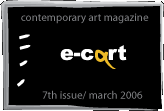 |
|
|
||||||||||||||||||
 |
 |
 |
|
|||||||||||||||||
| |
|
|||||||||||||||||||
 |
|
|
|
|||||||||||||||||
| |
|
|||||||||||||||||||
 |
|
|||||||||||||||||||
 |
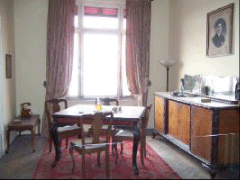 |
|
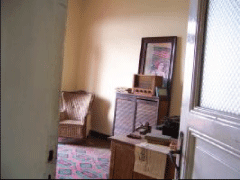 |
 |
|
|||||||||||||||
| |
 |
|
|
|||||||||||||||||
| |
|
|
|
|||||||||||||||||
| |
|
|
|
|
|
|||||||||||||||
| |
|
|||||||||||||||||||
| |
|
|
|
|||||||||||||||||
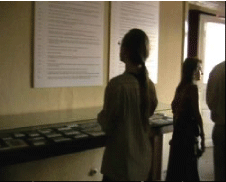 |
|
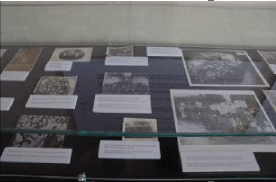 |
|
|||||||||||||||||
| |
|
|
||||||||||||||||||
 |
|
|||||||||||||||||||
 |
|
|||||||||||||||||||
 |
 |
|
||||||||||||||||||
| |
|
|
|
|
|
|
|
|
|
|
|
|
|
|
|
|
|
|
|
|